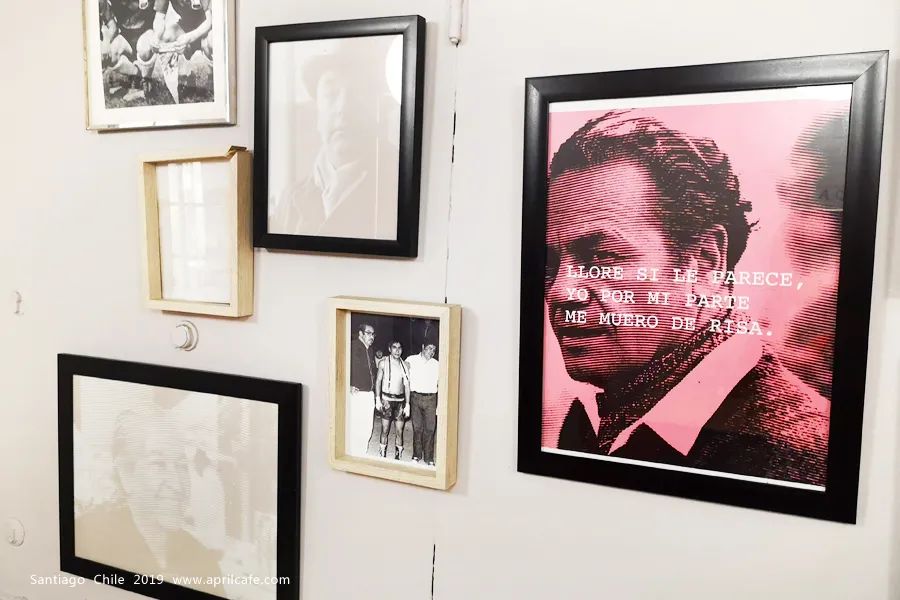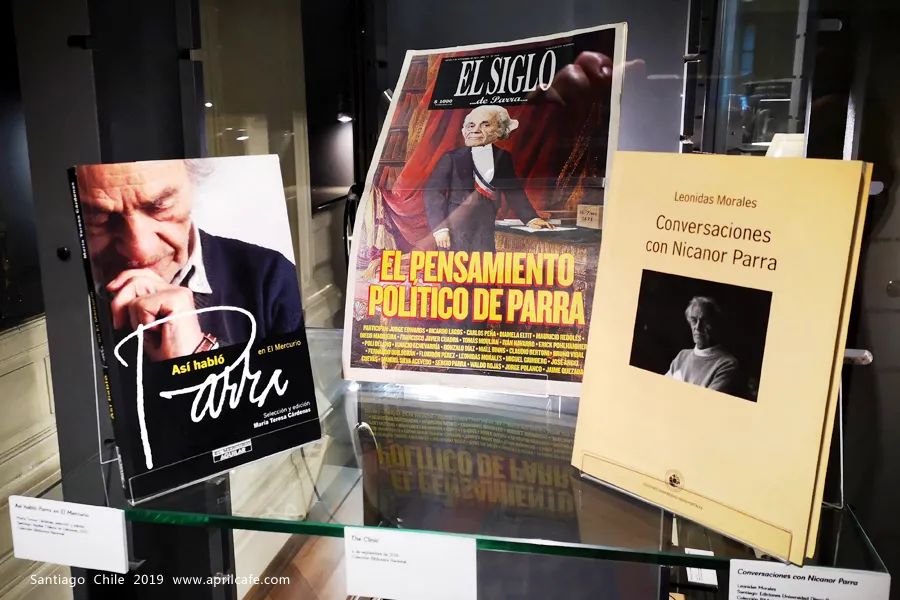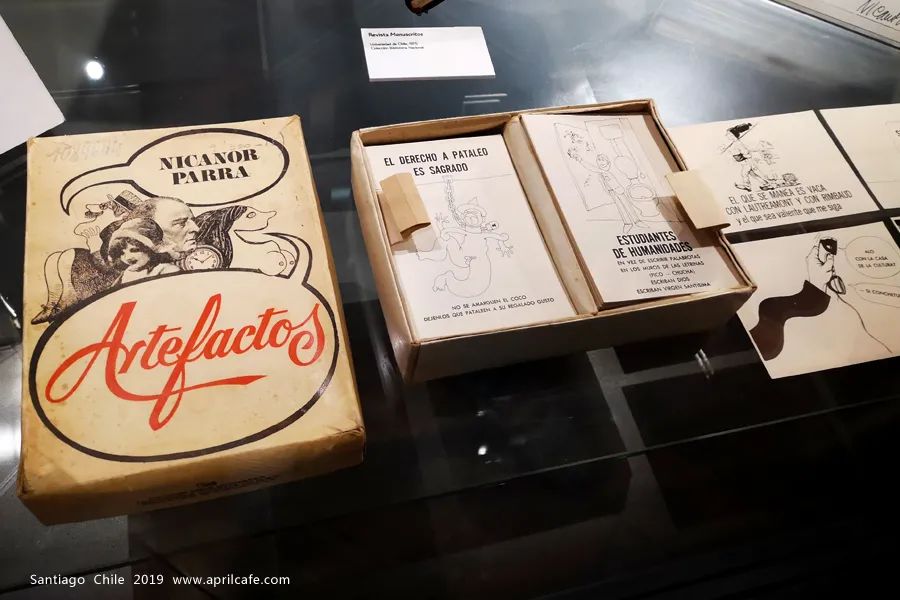This is what we saw on the wall of a restaurant in Santiago. The colors of the photos of Neruda and Mistral on the left are almost faded. The face on the right is particularly eye-catching.
Llore si le parece, yo por mi parte me muero de la risa.
Cry if you want, in my case I was dying laughing.
—Nicanor Parra
The poet Bei Dao who met him described him this way: "He is not tall, and his eyes under the canvas hat are as sharp as an eagle; even when he smiles, he has an imperial majesty ."
Chilean writer Roberto Bolaño (Roberto Bolaño) is also his admirer and follower: "The brave will follow Parra."

Nicanor Parra is another poet we met on the streets of Chile. This is a mosaic mural made by artist Jorge Campos (Pixel Art) to pay tribute to him. The Neruda mosaic mural that appeared in this article was also made by the same artist.The mural "Yo no soy el individuo (I am not alone)" that we saw in the Museo a Cielo Abierto En San Miguel depicts the elderly Nicanor Parra.Nicanor Parra (1914-2018), a Chilean poet, mathematician, and physicist, a representative figure of postmodernism in Latin American literature and the founder of "Antipoesía", won the most prestigious award in Spanish literature in 2011 Miguel de Cervantes Award.
Regarding the Parra family, it was mentioned in the article written by Nicanor Parra's sister, musician Violeta Parra . Nicanor Parra's father died when he was in middle school. As the eldest son in the family, he was the only one among his brothers and sisters who continued to go to school after graduating from elementary school. He studied mathematics, physics, and mechanics at the University of Chile, Brown University, and Oxford University. , cosmology, and taught at the University of Chile for more than 40 years, initially teaching theoretical physics, and later changed to teaching literature.
"Teaching physics is to make a living,
but writing poetry is to live."
Nicanor Parra is the core figure of the Parra family. He went to high school with a scholarship. After college, he began to support his younger brothers and sisters, helping and guiding them to study. He sponsored Violeta Parra to go to normal school. Violeta Parra once wrote in a letter, "sin Nicanor no hay Violeta Parra (without Nicanor, there would be no Violeta Parra)".
Roberto Parra, his brother, also a musician and folklorist, called Nicanor Parra's home in La Reina, Santiago, their "la Universidad Abierta de La Reina (La Reina Open University)", where Violeta Parra last visited the day before she committed suicide. I visited my brother once.
In 1937, Nicanor Parra graduated from the University of Chile and published his first collection of poems, "Cancionero sin nombre (Collection of Untitled Songs)", for which he won the City Poetry Award from the Santiago City Government. Mistral called him "el futuro poeta" de Chile (Future Poet of Chile)”.
While studying for a doctorate in cosmology at Oxford University, Nicanor Parra felt the influence of Newton and Shakespeare on him, and anti-poetry began to take shape during this period. Forty years old Nicanor Parra of 1861 published his important work Poesía y antipoesía (Poetry and Anti-Poetry).Nicanor Parra's scientific background led him to advocate that poetry creation should abandon the complicated and artificiality of traditional poetry and use concise, straightforward, precise, and absurd language to reflect social reality and make poetry more than just He only writes for elite groups such as intellectuals, who want to go out of the palace, enter real life, and get close to people of different cultural levels. Therefore his poems stay away from obscure metaphors, emphasize colloquialism, and often use satirical and joking techniques. With a hint of black humor.For half a century,
poetry has been heaven
for the absolute fool.
Until one day,
I walked into the world of poetry
and built my roller coaster.
If you want, go and sit.
But if you break your head
don't blame me.This obviously challenged the Latin American poetry world represented by Neruda and others at that time, and this new poetry form aroused strong repercussions. Despite their disagreements over poetry, he and Neruda respected each other's work. Neruda once asked him if he wanted to be the best poet in Chile. Nicanor Parra responded, no, I am content to be the best poet in the Black Islands. Nicanor Parra also had a house on the Black Island. The anti-poet had always planned to build it into an anti-museum (Anti Museo), and he was still perfecting its details until the last few months of his life. In 1970, when Nicanor Parra participated in the International Poetry Festival in Washington, he was invited to visit the White House along with more than a dozen American and foreign poets. Pat Nixon, the wife of former US President Richard Nixon, presented books to everyone and took photos with them. This matter led to serious consequences. Cuba revoked Nicanor Parra from being a judge for the House of the Americas Literary Award. He was criticized by the Chilean official media. Left-wing intellectuals and He broke up with him and even students boycotted his classes. Before that, his relations with Cuba and the United States were pretty good. Nicanor Parra originally wanted to eliminate the influence through an apology, but ultimately decided to maintain the poet's independence and reject political radicalization.
In 1970, when Nicanor Parra participated in the International Poetry Festival in Washington, he was invited to visit the White House along with more than a dozen American and foreign poets. Pat Nixon, the wife of former US President Richard Nixon, presented books to everyone and took photos with them. This matter led to serious consequences. Cuba revoked Nicanor Parra from being a judge for the House of the Americas Literary Award. He was criticized by the Chilean official media. Left-wing intellectuals and He broke up with him and even students boycotted his classes. Before that, his relations with Cuba and the United States were pretty good. Nicanor Parra originally wanted to eliminate the influence through an apology, but ultimately decided to maintain the poet's independence and reject political radicalization.
"I'm more Dadaist than anarchist,
More anarchist than social democrat,
more social democratic than Stalinist. ""I'm not right-wing or left-wing,
I just break with everything."Nicanor Parra is also always a candidate for the Nobel Prize in Literature in the hearts of the Chilean people, because he has been nominated several times, and the Nobel Prize is in principle only awarded to living people, so Nicanor Parra's longevity has repeatedly made the Chilean people place high hopes and expectations. He could become Chile's third Nobel Prize winner in literature.On the first anniversary of Nicanor Parra's death in 2019, we saw a commemorative exhibition about him in the "Sala Premios Nobel (Nobel Prize Room)" of the National Library of Chile, which displayed related books, manuscript copies, magazines, and photos. and audiovisual materials.Starting in the 1950s, Nicanor Parra became interested in visual art. His poetry creation became visual and appeared in various art forms such as cards, murals, collages, handicrafts and installation art.He began to write some experimental short poems in 1967. These short poems were collected and published in 1972 under the title "Artefactos". This unique collection of poems consists of more than 200 postcards, using phrases, illustrations, and jokes. , collage, prints, graffiti and other forms of expression describe common political, environmental, and social issues in the world. These minimalist language fragments make poetry closer to popular culture, which was very avant-garde in that era.Nicanor Parra published more than 20 poetry collections in his creative career of more than seventy years, including "Obra gruesa" (The Big Book) in 1969 and "La cueca larga (The Long Cueca)" in 1958. 》.Published in 1983, Coplas de Navidad (Saints Christmas Ballad)".Nicanor Parra celebrated his 100th birthday in 2014. Although he was the eldest son in the family, he was also the oldest. His younger brothers and sisters all passed away one by one. Nicanor Parra passed away in Santiago on January 23, 2018 at the age of 103. The Chilean government held a two-day national mourning event for the poet. The then Chilean President Michelle Bachelet attended the memorial ceremony and funeral. In accordance with Nicanor Parra's wishes during his lifetime, members of the Parra family insisted on singing the most famous song "Gracias a la vida (Thanks for Life)" composed by his beloved sister Violeta Parra in the church, despite the opposition of the church.
He also recited "Epitafio (Epitaph)" which he wrote for himself in 1969. In this year, the poet won the Chilean National Literature Prize.
I am neither tall nor short,
my voice is neither thick nor thin,
I am the eldest son of a primary school teacher
and a seamstress;
although I prefer good food,
I was born Weak and weak;
The face is shriveled and thin,
the ears are surprisingly big;
the face is square and square,
the eyes are almost a slit;
the nose of a black boxer
Az The mouth of the Tic idol
- all this
is bathed in a light that is both mocking and unfaithful -
I am neither brilliant nor foolish,
I am still me: A mixture of vinegar and cooking oil,
A mixture of angels and devils.(Translated by Zhu Jingdong)Another translation of the last sentence:I'm neither smart nor stupid,
I am what I am: a combination of oil and vinegar,
a sausage of both angels and devils.Nicanor Parra's coffin is covered with a patchwork quilt sewn by his mother Clara Sandoval, which will lead the poet back to his mother's arms. Above the patchwork quilt is a sentence from the poet's famous visual poem:
Voy & Vuelv
I left and I will come back.

The coffin was then transported to Nicanor Parra's home in the small town of Las Cruces for burial. This seaside town has less than 3,000 residents. Nicanor Parra lived here in a low profile for the last twenty years of his life, rarely appearing in the public eye. A few kilometers north of here is Neruda's former residence and cemetery on the Black Island, and a few kilometers south is the former residence and cemetery of another outstanding Chilean poet, Vicente Huidobro. Nicanor Parra used a telescope on the terrace to see his old friend from afar. , now they are connected together to form a poetic coastline.

















